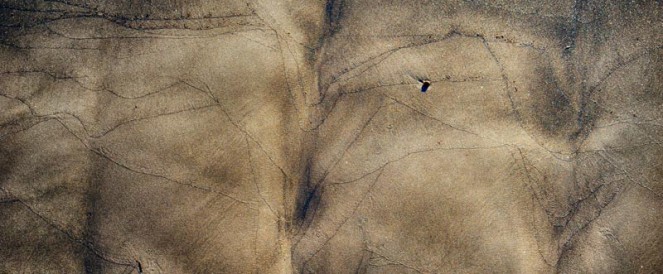The exhibition features large format photographs that were taken over several years on Southport Island in Maine. The first images, like many good experiences, were born of frustration—on a beach in Maine with good equipment and nothing to photograph. But I stayed and walked the sand, not looking for photographs but for a hint or a direction. It came when I began to take in these faint, fragile, complex and lively lines that recorded the receding tide. Of course walking back and forth on the beach, my footprints ruined that canvas. But coming back the next day, I walked carefully. A second beach isn’t far from the first, but the tide and sand created very different results. Images from both beaches are displayed in this show. The time of day, the phase of the tide, the time of the year, the weather that day, all have their say in the authorship of these images.
These images share a common impression of a three- (and four) dimensional world appearing quite real, although distorted by scale and a two-dimensional presentation (like painting and drawing). Many of these images juxtapose incongruities of space and content or abstract elements that emerge and provide their own narrative in otherwise straightforward images. Architectural geometries emerge as primary and formal shapes.
Although these images are simple and straight forward, there is a constant play between seeing them as landscapes and seeing them as abstraction, as painting, drawing, print. These images were photographed from only a few feet away, none more than 10 or 12 feet. The color in these photographs were in the sand, but in processing I’ve allowed color and contrast to move a little to make visible the patterns and tidal memory I wanted to explore. I have not attempted to hide or obscure anything—in this sense these are simple photographs.
Brief History
My first camera was my father’s 35mm Miranda D which we shared. I was 14 in 1961 when I won the local Cherry Blossom Festival photography contest which led to a job at two local newspapers, The Belleville Times and The Nutley Sun, photographing high school sports, civic events and even requests from the police to photograph accidents. The newspapers loaned me equipment well beyond what my family could afford—Nikon cameras, lenses, flash. I was paid a dollar for each photograph printed until they started printing more images; then $10 a week. This lush arrangement continued for the rest of high school; my father and I worked in the darkroom together making prints. This began a lifetime of exploration with photography.
Process
Digital photography, Photoshop, Lightroom and extremely fine digital printers allow the privacy, focus, and facility to become fully immersed in a process of producing images; the act of photography, the pleasure of the photograph, the slow process of seeing and working the image, the physical shift when the image is printed. I experience this as an opportunity to understand a constantly new language that I never fully understand; black & white, color, cropping, representation, abstraction, shading, saturation, print size, framing the print—what do these “mean?” Hundreds of decisions for each image and no clear understanding of what I was doing.
Over time, I begin to allow an exchange between the image and the work toward a print. At some point I take a photograph, see something that wants or demands or allows me to capture an image. Then later, looking at that image, I begin to see what I might have been seeing that I didn’t know; what aesthetic or social moment was alive just then.
The images are neither about creativity or beauty, although as emergent properties, I hope both appear on their own. The energetic space between “the conception and the creation” as Elliot says, the shadow, is an invitation. Often the sense of what I photograph gives way to another image as the process continues through printing. The distance between one and the other is an energy that can be followed, often only faintly felt. T.S. Elliot wrote in The Hollow Men,
Between the idea
And the reality
Between the motion
And the act
Falls the Shadow
…
Between the conception
And the creation
Between the emotion
And the response
Falls the Shadow
…
About the Prints
These photographs were printed on an Epson 9880 printer using Epson archival papers.
These large format photographs would not have been possible without the kind support, appreciation and encouragement of Professor Richard Wilde.
Dates
June 21–24, 2018
Admission
Free
Location
The Glass House
Gallery Hours
Thursday–Saturday, 1–7pm
Sunday, 1–5pm

